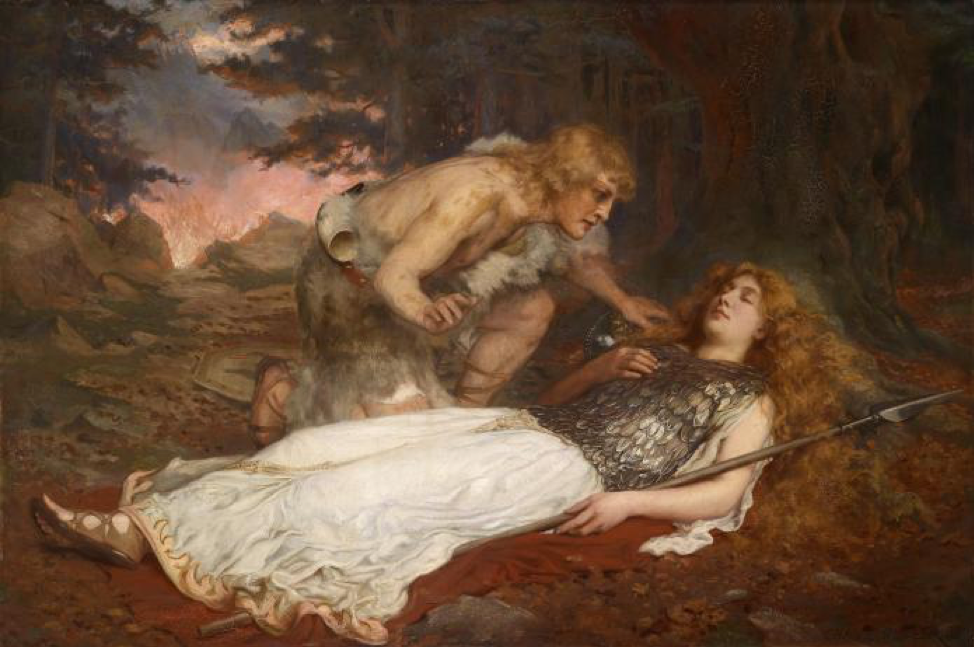Relationships of New Depths in William Morris’ “Sigurd the Volsung”
By Emily Wright.
William Morris wrote “Sigurd the Volsung” as a retelling of some of the central episodes within the Saga of the Volsungs. He relies heavily on the plot of the Saga, yet, through dialogue and figurative language, Morris adds significant details to the stories that were not present in the original text. For example, the episode “Regin and Sigurd Go Riding” in the Saga of the Volsungs is a relatively short passage consisting of Sigurd slaying the evil serpent Fafnir, who is Regin’s brother. In the Saga, when asked by Fafnir why Sigurd would kill him despite the intense fear people usually have in his presence, Sigurd replies, “A hard mind whetted me for this deed and I was supported in it by this strong hand and this sharp sword,” (Saga 64). In “Sigurd the Volsung,” when discussing with Regin his motivations for taking on the task, Sigurd says, “O Regin, in good sooth, / I have hearkened not nor heeded the words of thy fear and thy ruth: / Thou hast told thy tale and thy longing, and thereto I hearkened well,” (Morris 106). While he is stating similar ideas to those that were conveyed in the Saga, Morris is also allowing for the characterization of Sigurd as someone who set aside fear for the purpose of helping another, and is in turn emphasizing his valor and selflessness. He ignores Regin’s warnings of the dangers Fafnir presents, and instead focuses solely on Regin’s story and desire to avenge his family. This quote, in addition to the rest of the dialogue in the beginning of Book II between Regin and Sigurd, offer new depths to Sigurd and Regin’s relationship that the Saga of the Volsungs does not. In turn, this relationship of new depths increases the tragic quality to Sigurd’s ultimate murder of Regin.
In another episode of the Saga of the Volsungs, Sigurd encounters Brynhild stuck in a coat of armor, and uses his sword to free her. The Saga states that Sigurd, “sliced through the armor, down from the neck opening and out through the sleeves, and it cut like cloth. Sigurd said she had slept too long” (Saga 67). The brevity of this description prevents the development of any real foundation for Sigurd and Brynhild’s eventual relationship. Morris, however, writes that, in their first encounter, Brynhild, “turned and gazed on Sigurd, and her eyes met the Volsung’s eyes. / And mighty and measureless now did the tide of his love arise, / For their longing had met and mingled, and he knew of her heart that she / loved,” (Morris 124). Morris, here, is offering a significantly more emotional description of two lovers meeting for the first time. Their love developed quickly at first sight, and was so strong it was “measureless.” Morris dramatizes what was initially a very small moment in the Saga. Through this, once again, Morris is deepening the relationships between the figures of the Saga of the Volsungs, and allowing for them to become fully formed characters in his poem.

The same themes can be seen in the painting by Charles Butler above, where Brynhild is depicted as a beautiful, innocent woman, despite the coat of armor she is wearing, and Sigurd seems to be entirely captivated by her beauty. The fact that Brynhild remains asleep with her eyes closed, while Sigurd falls deeply in love with her appearance, demonstrates the Victorian expectation of women to dedicate their lives only to pleasing their husbands, and to always remain docile and passive. Victorian women were seen as living only for the men around them. This painting offers a different interpretation of their meeting than that which is within the Saga, where Sigurd encountered Brynhild, and originally thought her to be a man. Clearly, the romantic undertones Morris included in Brynhild and Sigurd’s interactions were a result of certain artistic movements of the Victorian Age that also impacted the paintings of Charles Butler.





